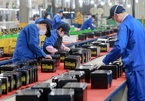According to Minister Nguyen Chi Dung, Covid-19 has disrupted production and business activities of enterprises around the world and seriously affected the Vietnamese economy. Along with that, the epidemic has disrupted many supply chains in the world and Vietnam.
However, when the economy recovers from the pandemic, demand will also increase. Vietnam needs to take advantage of this opportunity to bring businesses into the supply chain.
Growth and opportunity
 |
The Ministry of Planning and Investment and the United Nations Development Program (UNDP) in Vietnam researched and re-evaluated the impact of the Covid-19 epidemic on the supply chain of 10 industries in Vietnam. They selected three priority industries for in-depth research: agriculture, food processing and automobiles. These are the three industries that are said to have great opportunities to develop and join the global supply chain after the pandemic.
The agriculture and food processing industries are recognized as having great potential in terms of exports and joining global chains; the automobile industry with the trend of switching to electric vehicles and the shift of the global supply chain of multinational companies will create opportunities for Vietnamese businesses.
Although in the first half of the year Vietnam faced two pandemic waves and the world was still in a complicated Covid-19 situation, Vietnam's production and exports still grew and there was great expectation as the world moved towards the "new normal" period.
Data from the Ministry of Industry and Trade shows that many industrial products of Vietnam grew highly in the past seven months of 2021: rolled steel increased by 55.9% year on year; mobile phone components by 40%; automobiles by 39.6%; footwear by 19.3%, mobile phones by 14.1%; fabrics increased by 10.6%...
A report of the Ministry of Agriculture and Rural Development indicated that the export of agricultural, forestry and fishery products still increased sharply, reaching over 24.23 billion USD, up 28.2% over the same period in 2020. Exports to major markets such as the US and China grew well.
The Ministry of Industry and Trade forecasts that the demand for export goods is still high. The fact that countries are vigorously implementing vaccination and reopening their economy has increased demand for Vietnam's textiles, footwear, furniture, and electronics. Besides, a number of economies continue to implement demand stimulus packages, through direct support to people, thereby promoting the consumption of goods, including those imported from Vietnam.
After the pandemic, the demand for agriculture, forestry and fishery products continues to have great potential in the US and EU markets. According to the Ministry of Planning and Investment, the agricultural sector is forecast to benefit the most from the EU-Vietnam Free Trade Agreement (EVFTA) because many Vietnamese products will be taxed to 0%.
According to forecasts, by 2025, the export of agricultural, forestry and fishery products will reach over 50 billion USD and over 60 billion USD by 2030.
 |
|
|
For the car manufacturing industry, the trend to switch to electric vehicles is stronger. It is forecasted that by 2030, Vietnamese will buy 1 million cars per year. The number of electric vehicles will increase. As for the world market, according to Frost and Sullivan Company, by 2030, electric vehicles (EVs) and gasoline hybrid electric vehicles (PHEVs) will account for 30% of total automobile sales. The trend of automobile production chains is shifting to Vietnam. This is an opportunity for Vietnamese businesses to participate in the global supply chain of electric vehicle components.
However, the Ministry of Planning and Investment also warns about limitations.
Agriculture and food processing face problems such as underdeveloped logistics system. The main distribution channels are cross-border exports and traditional markets; and the ability to apply international standards and traceability to meet the requirements of the international market is not high. The capacity in product research and development and brand building capacity are also very weak.
As for automobiles, there are inherent problems such as: small scale and low competitiveness in terms of cost, domestic enterprises that only participate in simple stages, and low localization rate.
The epidemic has affected the entire world, causing heavy economic losses. However, besides the bad effects, in a more positive aspect, the Covid-19 pandemic has become a new catalyst to accelerate the digital transformation process, opening up a new era for the digital economy.
According to international research organizations, Vietnam has been one of the best performing economies in the world during the Covid-19 pandemic, with the digital economy expected to explode in the near future. A study by Alphabet Temasek Holdings and Bain&Co indicates that Vietnam's digital economy may grow to US$52 billion by 2025, an annual increase of 29% compared to that of 2020.
The Vietnamese government has set a target that online shopping will account for 10% of the country's retail sales and up to 50% in Hanoi and Ho Chi Minh City by 2025, which also opens up many opportunities for the digital economy.
The Institute for Economic and Policy Research (VEPR) has recently released the Vietnam Economic Annual Report 2021 with the theme "Repositioning Vietnam in the context of global changes," which pointed out many opportunities for Vietnam's economy after the pandemic. The report says that the pandemic has disrupted value chains, leading to restructuring and Vietnam has the opportunity to become a new production base.
The trade war between major powers has helped Vietnam take advantage of this opportunity and fill the gap created by the market. The implementation of signed free trade agreements will help Vietnam increase the quantity and quality of trade and investment, diversify partners and participate in value chains... For a young and dynamic economy like Vietnam, the digital economy is considered a new strength for the country’s economy.
How to catch the opportunity
 |
The opportunity is great, but can Vietnam can seize this opportunity? Experts say that Vietnam's total import-export turnover in 2019 (before the Covid-19 epidemic) reached 517 billion USD, while GDP reached 265.9 billion USD. Global trade was high, but the GDP per capita was relatively low ($2,715/year), meaning that when participating in the global supply chain, Vietnam does not get much.
Data from the World Bank (WB) shows that Vietnam only generated 20.4 billion USD through participating in global supply chains in 2018, ranking 53rd out of 174 countries. Meanwhile, in Southeast Asia, the Philippines (34th in the world) generated more than 84 billion USD.
At the same time, Vietnam's participation in sophisticated and complex stages is still low. The global value chain currently accounts for 66% of trade transactions, but Vietnam's localization level is only 28% of total trade turnover, nearly 2 times lower than that of China.
In terms of exports, the FDI sector accounts for more than 70% of the country's total turnover. FDI enterprises lack links with Vietnamese enterprises and do not bring spillover effects to the economy. Meanwhile, few domestic firms participate in the supply chain and they only perform simple steps with low added value. Most private enterprises in Vietnam have micro-scale, small capital, low number of trained workers, outdated technology and low productivity. These problems will hinder opportunities for Vietnamese enterprises to join global supply chains after the pandemic.
Experts suggest that Vietnam needs to persevere with long-term reforms to improve the macro foundation and reduce risks in the future. It is necessary to promote economic growth in depth based on innovation, improve labor productivity, apply scientific and technological advances, improve the quality of human resources, and promote comparative advantages. Business environment reform must be considered a permanent requirement, especially in localities. At the same time, improving the skills of the workforce will be the basic premise to capture more value created from the global supply chain.
Many foreign-invested (FDI) firms are expanding their investments to take advantage of opportunities. It is necessary to create a close connection between FDI and domestic enterprises to take advantage of this opportunity. Also, the strategy of attracting FDI must be changed, towards attaching FDI attraction to national development strategies and plans, forming supply chains and industrial clusters, focusing on industries and stages that create high added value, using environmentally friendly technology with low energy consumption.
However, the FDI sector is only a driving force, and strong domestic enterprises are a solid foundation to join the supply chain. Therefore, it is necessary to build a force of qualified domestic enterprises with modern technology and competitiveness in order to seize opportunities and participate in the global supply chain.
In the current situation, it is especially necessary to support businesses to promote digital transformation. Digital transformation must be considered the leading solution to modernize and improve productivity.
Vietnam has many more infrastructure and Internet advantages. Appota said that Vietnam is in the top 12 countries with the cheapest Internet charges globally, about $11.27/month/subscriber. Accessible rates make the Internet widely available throughout the country, especially mobile Internet.
In addition, smartphones are being prioritized as the main connection device thanks to convenience and popularity, development of Internet infrastructure and quality in Vietnam, with mobile Internet speed significantly improved, ranking second in Southeast Asia. The digital transformation policy is also leading Vietnamese enterprises through a new dynamic and more effective era - the digital era.
Tran Thuy

Reform measures prepare for post-pandemic period
When the pandemic ends, demand will increase and the economy will recover. To prepare for this, it’s necessary to carry out strong reform and create the most favorable business environment for enterprises.

Tardy public spending will hinder post-pandemic economic recovery
The COVID-19 health crisis and the resulting economic downturn has thrown a spanner in the works of already tardy public spending, hindering Vietnam’s efforts to revive its post-pandemic economy and speed up slowing GDP growth.